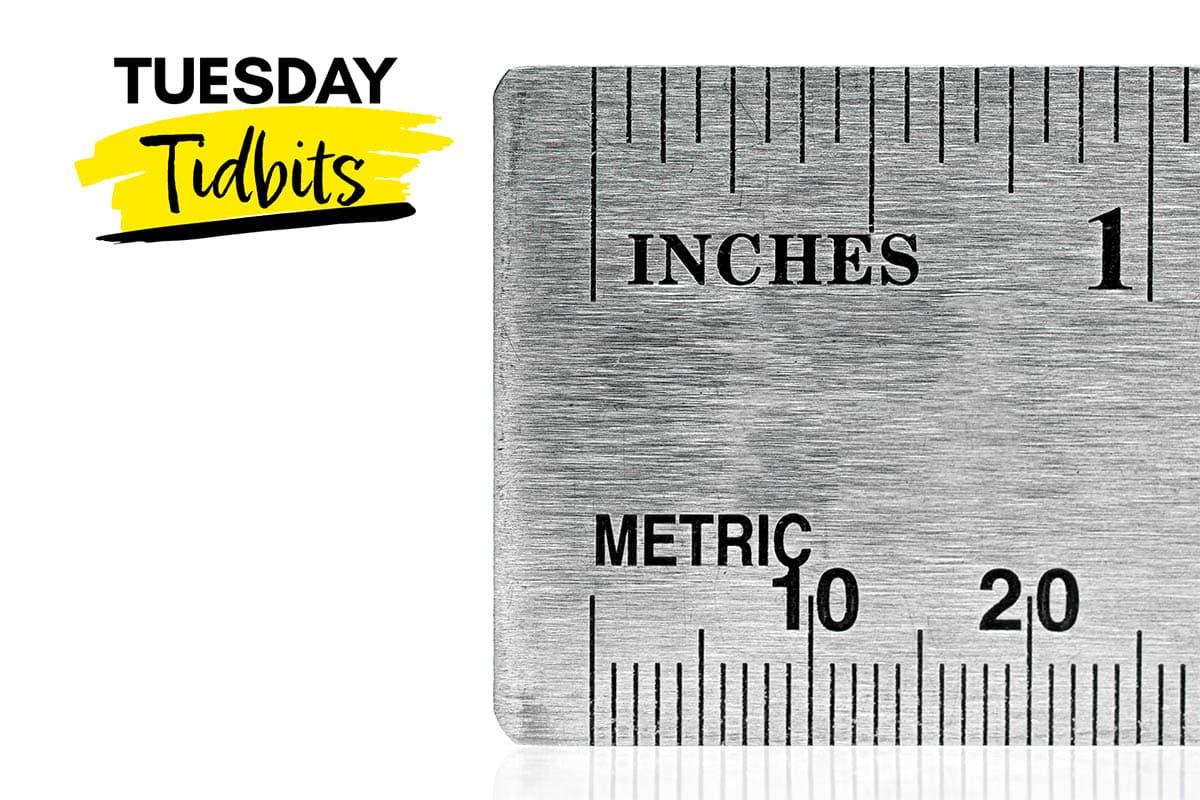Try ordering a 113.3981-grammer burger at your local McDonald’s or Burger King. And then don’t be surprised when they don’t understand your order! That’s because the United States has not yet fully adopted the metric system. As a result, most U.S. citizens are not familiar with it. We don’t measure our quarter-pound burgers in grams. We measure them in fractions of pounds. In this example, one-quarter pound. That’s why we call that particular burger a “quarter-pounder.”
And that just might explain why the U.S. still isn’t on board with nationwide metrication. After all, “quarter-pounder” has much better marketing “zing” than does “113.3981-grammer.” Moreover, in our colloquial-ridden American speech, it makes perfect sense to us.
We Are Not Alone in Imperial Measurements
Most people who grew up learning how to measure in ounces, pounds, yards, miles, gallons and Fahrenheit, liken the metric system to a hard-to-learn foreign language. Most other countries around the world have transitioned from traditional units of measurement to the metric system. This process began in France during the 1790s and continues to the present day.
In spite of that, however, the metric system has not been fully adopted in all countries, including the United States. As of 2021, the U.S., Myanmar and Liberia are the only countries that have not officially adopted metrics as the primary means of weights and measures.
The big question is, why? Is it really all about being able to call our favorite burger a quarter-pounder? Or are there other reasons why we are so resistant to metrication?
Our Imperial Life
The first thing we need to remember is that, here in the U.S., we are dug deep into our mega-ounce coffee cups and the number of gallons of gas it takes to fuel our vehicles. While we use some metric measurements (e.g., one-liter soda bottles), most of our weights and measurements are still imperial (ounces, gallons, yard, miles, etc.). And the longer that goes on, the more deeply attached we are to them.
Simply put, we’re in an imperial-measurement rut. As nonsensical as imperial measures are, we have somehow or another managed to memorize that 12 inches equals one foot and 16 ounces equals one pound. We’re not about to joyfully abandon all of that hard work!
Yet, on the positive side, the metric system is an easier way to go about standardizing measurements than the imperial system is. Here’s why: Everything in the metric system divides into decimals (there are 10 millimeters in a centimeter, 1,000 grams in a kilogram, and so on). Inarguably, the metric system just makes sense. And that’s why almost all of the rest of the world uses it.
For example, water freezes at zero degrees Celsius (as opposed to the random 32 degrees Fahrenheit) and it boils at 100 C (instead of 212 F). As a result, the metric system doesn’t require us to memorize a lot of confounding temperature measurements.
At the same time, it’s mindboggling to think of just how many signs, instructions and other information would have to be changed if the U.S. were to seriously embark on metrication.
And, that just doesn’t make sense.
Aren’t We Officially Metricated?
The funny thing about this weights and measurements conundrum is that in 1975, the U.S. passed official legislation for metrication. Interestingly, conversion to the system was not mandatory, so many industries chose not to convert to it.
Almost twenty years later, on July 25, 1991, Executive Order 12770, otherwise known as the Metric Conversion Act, was signed by President George H.W. Bush. The order directed departments and agencies within the executive branch of the U.S. Government to take all appropriate measures within their authority to use the metric system as the preferred system of weights and measures for U.S. trade and commerce.
The executive order also authorized the Secretary of Commerce to form an Interagency Council on Metric Policy (ICMP), the purpose of which would have been to assist in the coordination of the Federal Government’s implementation of the order.
The problem is that, unlike other countries, in the U.S., there is no government-wide or major social desire to implement metrication. It should come as no surprise, then, that the order was never carried out. The best the U.S. has been able to achieve is a presentation of metric measurements alongside their imperial equivalents on things like measuring cups and soda bottles.
Hang onto your quarter-pounder, cooked to an optimal internal temperature of 160 degrees Fahrenheit. The road to metrication is going to continue to be a bumpy ride here in the U.S.








The Imperial System has lasted as long as it has because it works. Many other countries had measurement systems that did not work nearly as well as either the metric or Imperial system, and because most of those other countries were colonized by the French or Spanish, they more readily adopted the metric system.
The Imperial System has an internal logic that works quite well and honestly feels more human and relatable than the metric system. It also has the benefit of being easy to divide by 2, 3, and 4. Also, remember that your clocks operate on the same idea as the Imperial System and no one is complaining that we haven’t adopted a Base 10 time system.
The metric system is immensely important when working in the scientific field and when working with very small and very large numbers. But when working with things on the human scale, I find the Imperial System to be far superior.
Don’t forget about all of the high cost manufacturing equipment that would need to be replaced, as they nearly all use the Imperial system. No one is going to reimburse those expenses. Plus, ever try to buy a metric 2×4 or sheet of plywood? I tried to bid on a metric based building in the mid-1990s. Most subcontractors would not even offer a bid because they had no desire to even buy metric tape measures, let alone learn conversions.
So 0 and 100 are easier to remember and more “scientific” and less “random” than 32 and 212?
America uses US Customary Units, not imperial. We sorted this out back in ’76.
Before I begin, I am noticing a lot of confusion between non-metric “Imperial” units and non-metric “U.S. Customary units.” Imperial pints and gallons are NOT the same as U.S. pints and gallons. Better leave the Imperial stuff to the Brits, and use “US customary” to denote American units. Now with that out of the way, there are still several strong reasons that English speakers in nations not already using metric standards will resist changing over.
1) Many English unit names are falling-stress words having closed consonant groups of one or two syllables. This makes them easier to speak than three- and four-syllable metric unit names of Greek or Latin origin. Those are soft-hand, first class cabin passengers borrowed into our language and they don’t fit in with the Anglo-Saxon and Germanic engine room, the stope of a mining seam, or out back in the barn, paddock or stable where “real work” is done.
2) Many English unit names are one-word operational definitions. They name the tool and a user knows what to do or how the jury rig an approximate equivalent in the field to be re-calibrated against the official standard later. Your body already has an approximate foot, inch (thumb,) handspan, cubit, yard, and fathom. Walk 1,000 paces and you have a mile, thanks to the Roman legions. Cups, rods, bushels, barrels, hogsheads and chains literally tell you how to measure with them. Scientists’ last names provide no such clues. I can get a horse from up the road and put it to work lifting 550 pounds in 1 second and know it has expended 1 horsepower. How many James Watts does that get me? Also, that 1 of these times 1of those equals 1of these is not exclusive to the metric system – 1 BTU of energy will heat 1 pound of liquid water by 1 degree F.
3) Rather than scientific notation spacing out unit names by powers of 10, 100, and 1000, many measurement tasks have a dozen English units spaced apart closer to the natural log [e,] when you average out all the doubling and halving systems and other systems that compare at 4:1, 5:1 and 8:1. This means that for most informal household and homestead tasks, a unit may be selected that expresses the desired quantity as an single-digit or a low two-digit integer plus a fraction. This is a “CYA” move; the recipe calls for 2 cups and there’s a little bit left in the box so you finish it off and get 2 1/4 cups. In metric that 1/4 cup emotionally feels “close enough – only off by a quarter” but in metric you are off by 59cc and by that system you feel inaccurate and incompetent. Geeky SF characters like Spock or Data from Star Trek are often ridiculed for applying precision where it is socially inappropriate. Three-place exactitude of the laboratory is similarly out of place when baking muffins or shoeing draft horses.
To get around these obstacles to adoption, we might consider creating new measuring tools with simple names so that people encounter metric units in more common and friendly ways. Make 1-liter kitchen “lits” (an easy, Anglo-sounding word) for measuring 1-litre volumes, and perhaps sneak sugar cubes away from 1tsp rectangular blocks to 1cc cubes, but you may want to add names for quinary sub-bases (the V, L, and D, between Roman numerals I, X, C, and M,) or other intervals perhaps at 1/4-ten, 1/2-10, and 3/4-ten existing between 1 and 10, and 25, 50, and 75 unit intervals between 10 and 100. Then, remember to NOT names these sub-units after people or places, rather name them after common objects or produce and sell new measuring objects that are representative of the quantities they represent – and remember to use English syllables, of which there are about 8,000 possible vowel and consonant clusters for single syllables,
My thought is that the existing infrastructure is why it is so difficult to change from Imperial to metric units. Changing signs is difficult enough, but changing the steel, aluminum, and wood that holds those signs with metric shapes and standards is impossible. A C6x13 can be measured and defined with metric units, but a metric beam does not have the same dimensions. A metric beam cannot replace an Imperial beam without replacing all the interfacing members or adding custom shims. Flawed or not, I think it is here for good.
As someone who spent an engineering career working predominantly in “U.S. Customary Units” I never could (and still cannot) understand the reluctance to change to the simpler and easier metric system (not to mention the fact that having multiple systems often requires conversions – ask NASA about that). Inertia I guess.
Sure glad I switched from Windows to Mac computing several years ago, even though many engineering applications are still compatible with Windows computers only.